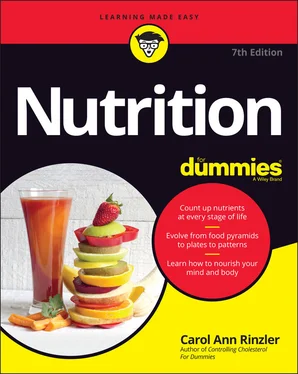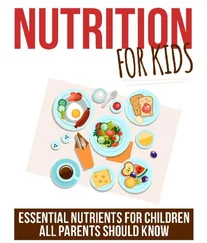1 ...8 9 10 12 13 14 ...18 Estimated Average Requirement (EAR): The amount that meets the nutritional needs of half the people in any one group (such as teenage girls or people older than 70). Nutritionists use the EAR to figure out whether an entire population’s normal diet provides adequate amounts of nutrients.
Recommended Dietary Allowance (RDA): The RDA, now based on information provided by the EAR, is still a daily average that meets the needs of 97 percent of a specific population, such as women age 18 to 50 or men age 70 and older.
Adequate Intake (AI): The AI is a new measurement, providing recommendations for nutrients for which no RDA is set. ( Note: AI replaces ESADDI.)
Tolerable Upper Intake Level (UL): The UL is the highest amount of a nutrient you can consume each day without risking an adverse effect.
The DRI panel’s first report, listing new recommendations for calcium, phosphorus, magnesium, and fluoride, appeared in 1997. Its most notable change was upping the recommended amount of calcium from 800 milligrams to 1,000 milligrams for adults age 31 to 50 as well as postmenopausal women taking estrogen supplements; for postmenopausal women not taking estrogen, the recommendation is 1,500 milligrams.
The DRI panel’s second report appeared in 1998. The report included new recommendations for thiamin, riboflavin, niacin, vitamin B6, folate, vitamin B12, pantothenic acid, biotin, and choline. The most important revision was increasing the folate recommendation to 400 micrograms a day based on evidence showing that folate reduces a woman’s risk of giving birth to a baby with spinal cord defects and lowers the risk of heart disease for men and women. (See the sidebar “Reviewing terms used to describe nutrient recommendations” in this chapter to brush up on your metric abbreviations.)
As a result of the 1998 DRI panel’s report, the FDA ordered food manufacturers to add folate to flour, rice, and other grain products. (Multivitamin products already contain 400 micrograms of folate.) In May 1999, data released by the Framingham Heart Study, which has followed heart health among residents of a Boston suburb for nearly half a century, showed a dramatic increase in blood levels of folate. Before the fortification of foods, 22 percent of the study participants had folate deficiencies; after the fortification, the number fell to 2 percent.
A DRI report with revised recommendations for vitamin C, vitamin E, the mineral selenium, beta carotene, and other antioxidant vitamins was published in 2000. In 2001, new DRIs were released for vitamin A, vitamin K, arsenic, boron, chromium, copper, iodine, iron, manganese, molybdenum, nickel, silicon, vanadium, and zinc. In 2004, the Institute of Medicine (IOM) released new recommendations for sodium, potassium, chloride, and water, plus a special report on recommendations for two groups of older adults (age 50 to 70 and 71 and over). By 2005, the Food and Nutrition Board had established an AI of 600 IU (international units) vitamin D for men and women older than 71. Put all these findings together, and they spell out the recommendations you find in this chapter.
Table 3-1shows the most recent RDAs for vitamins for healthy adults; Table 3-2shows RDAs for minerals for healthy adults. Where no RDA is given, an AI is indicated by an asterisk (*) by the column heading.
REVIEWING TERMS USED TO DESCRIBE NUTRIENT RECOMMENDATIONS
Nutrient listings use the metric system. RDAs for protein are listed in grams. The RDA and AIs for vitamins and minerals are shown in milligrams (mg) and micrograms (mcg). A milligram is 1/1000 of a gram; a microgram is 1/1000 of a milligram.
Vitamin A, vitamin D, and vitamin E are special cases. For instance, one form of vitamin A is preformed vitamin A, a form of the nutrient that your body can use right away. Preformed vitamin A, known as retinol, is found in food from animals — liver, milk, and eggs. Carotenoids (red or yellow pigments in plants) also provide vitamin A. But to get vitamin A from carotenoids, your body has to convert the pigments to chemicals similar to retinol. Because retinol is a ready-made nutrient, the RDA for vitamin A is listed in units called retinol equivalents (RE). One microgram (mcg) RE is approximately equal to 3.33 international units (IU, the former unit of measurement for vitamin A).
Vitamin D consists of three compounds: vitamin D1, vitamin D2, and vitamin D3. Cholecalciferol, the chemical name for vitamin D3, is the most active of the three, so the RDA for vitamin D is measured in equivalents of cholecalciferol.
Your body gets vitamin E from two classes of chemicals in food: tocopherols and tocotrienols. The compound with the greatest vitamin E activity is a tocopherol: alpha- tocopherol. The RDA for vitamin E is measured in milligrams of alpha-tocopherol equivalents (a-TE).
Nutrient amounts are measured in various units:
g = gram
mg = milligram = of a gram
mcg = microgram = of a gram
IU = international unit
RE = retinol equivalent = the amount of “true” vitamin A in an IU
a-TE = alpha-tocopherol equivalent = the amount of alpha-tocopherol in a unit of vitamin E
TABLE 3-1Vitamin RDAs for Healthy Adults
| Age (Years) |
Vitamin A (RE/IU)† |
Vitamin D (mcg/IU)‡* |
Vitamin E (a-TE) |
Vitamin K (mcg)* |
Vitamin C (mg) |
| Males |
|
|
|
|
|
| 19–30 |
900/2,970 |
15/600 |
15 |
120 |
90 |
| 31–50 |
900/2,970 |
15/600 |
15 |
120 |
90 |
| 51–70 |
900/2,970 |
15/600 |
15 |
120 |
90 |
| 71 and older |
900/2,970 |
20/800 |
15 |
120 |
90 |
| Females |
|
|
|
|
|
| 19–30 |
700/2,310 |
15/600 |
15 |
90 |
75 |
| 31–50 |
700/2,310 |
15/600 |
15 |
90 |
75 |
| 51–70 |
700/2,310 |
15/600 |
15 |
90 |
75 |
| 71 and older |
700/2,310 |
20/900 |
15 |
90 |
75 |
* Adequate Intake (AI)
† The “official” RDA for vitamin A is still 1,000 RE/5,000 IU for a male, 800 RE/4,000 IU for a female who isn’t pregnant or nursing; the lower numbers listed on this chart are the currently recommended levels for adults.
‡ The current recommendations are the amounts required to prevent vitamin D deficiency disease; recent studies suggest that the optimal levels for overall health may actually be higher, in the range of 800–1,000 IU a day.
| Age (years) |
Thiamin (Vitamin B1) (mg) |
Riboflavin (Vitamin B2) (mg) |
Niacin (NE) |
Pantothenic acid (mg)* |
Vitamin B6 (mg) |
Folate (mcg) |
Vitamin B12 (mcg) |
Biotin (mcg)* |
| Males |
|
|
|
|
|
|
|
|
| 19–30 |
1.2 |
1.3 |
16 |
5 |
1.3 |
400 |
2.4 |
30 |
| 31–50 |
1.2 |
1.3 |
16 |
5 |
1.3 |
400 |
2.4 |
30 |
| 50–70 |
1.2 |
1.3 |
16 |
5 |
1.7 |
400 |
2.4 |
30 |
| 71 and older |
1.2 |
1.1 |
16 |
5 |
1.7 |
400 |
2.4 |
30 |
| Females |
|
|
|
|
|
|
|
|
| 19–30 |
1.1 |
1.1 |
14 |
5 |
1.3 |
400 |
2.4 |
30 |
| 31–50 |
1.1 |
1.1 |
14 |
5 |
1.3 |
400 |
2.4 |
30 |
| 51–70 |
1.1 |
1.1 |
14 |
5 |
1.5 |
400 |
2.4 |
30 |
| 71 and older |
1.1 |
1.1 |
14 |
5 |
1.5 |
400 |
2.4 |
30 |
| Pregnant |
1.4 |
1.1 |
18 |
6 |
1.9 |
600 |
2.6 |
30 |
| Nursing |
1.4 |
1.1 |
17 |
7 |
2.0 |
500 |
2.8 |
35 |
* Adequate Intake (AI)
Читать дальше












